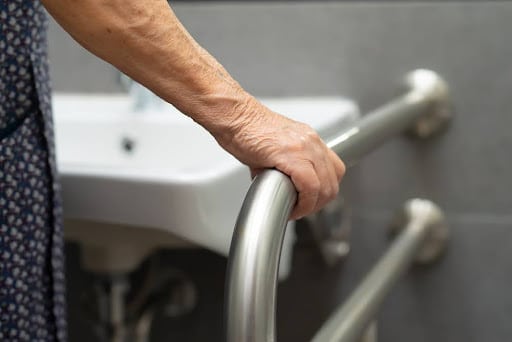Updated July 2025
What’s in This Article 🔎
(Tap any heading to jump straight there.)
Why the Right Bathroom Aids Matter
The bathroom is the most accident‑prone room for older adults and anyone living with mobility or balance issues. Simple tasks—standing to shower, stepping into a bath, lowering onto a toilet—quickly become high‑risk without the correct support. Installing bathroom aids for the elderly and disabled reduces falls, eases joint pain and restores independence.
The NHS reports that one in three adults 65+ will fall at least once a year, with the bathroom topping the list for location of injuries.

11 Essential Bathroom Aids for the Elderly & Disabled
| # | Aid | How It Helps | Best For |
|---|---|---|---|
| 1 | Safety rails & grab bars | Fixed or folding hand‑holds for secure transfers | Anyone with poor balance or lower‑body weakness |
| 2 | Shower chairs & stools | Seated washing, reduced fatigue | Users who struggle to stand > 2 min |
| 3 | Transfer benches | Slide across bath edge without lifting legs over | Hip surgery, stroke, severe arthritis |
| 4 | Rising bath lifts / cushions | Battery‑powered or inflatable seat lowers & raises | Wheelchair users, limited trunk control |
| 5 | Fixed bath seats | Extra support inside walk‑in baths | Those needing stability but able to stand |
| 6 | Bath steps with non‑slip surface | Reduces step‑in height by 10–15 cm | Joint pain, reduced vision, cognitive decline |
| 7 | Slip‑resistant mats | Instant grip inside & outside wet zones | Budget safety upgrade for any household |
| 8 | Long‑handled washing aids | Bendable sponges, toe washers, lotion applicators | Limited reach or shoulder issues |
| 9 | Hair‑washing tray | Keeps water off face & back; carer‑friendly | Dementia, vertigo, wheelchair users |
| 10 | Raised toilet seats | Adds 5–13 cm height, less knee/hip strain | Osteoarthritis, Parkinson’s |
| 11 | Toilet frames & commode chairs | Side rails or mobile seat for safe transfers | Severe balance problems or no downstairs WC |

Choosing the Safest Aid for Each Task
| Bathroom Task | Top Aid Choice | Why |
|---|---|---|
| Showering while seated | Shower chair with back & arms | Prevents sliding; arms aid sit‑to‑stand |
| Bath transfers | Transfer bench + grab bar | Eliminates high step, offers dual support |
| Toileting with poor leg strength | Raised toilet seat + floor‑fixed frame | Raises seat height and adds lateral stability |
| Independent hair washing | Hair‑washing tray or rotating shower stool | Keeps head steady without neck strain |

Professional vs DIY Installation
| Aid Type | DIY‑Friendly? | Why / Why Not |
|---|---|---|
| Slip‑resistant mats, bath steps, long‑handled sponges | ✅ Yes | No fixings; instant placement |
| Suction grab bars | ⚠️ Short‑term only | Lose grip over time; not weight‑bearing |
| Screw‑fixed grab rails, shower seats | ❌ Hire a pro | Must locate studs & seal waterproof fixings |
| Electric bath lifts, commode shower chairs | ✅ Assembly only | No hard wiring; follow manual |
| Raised toilets, power bidets | ❌ Hire a pro | Plumbing & Part P electrics (UK regs) |
Grants, Funding & Free Assessments
- Disabled Facilities Grant (DFG): Up to £30,000 in England & Wales for major adaptations (wet rooms, accessible baths).
- NHS & Local Council Equipment Loans: Free grab rails, frames, or commodes after an occupational‑therapy home assessment.
- Charities & Trusts: Look to Independence at Home, or Turn2Us for small grants covering bathroom aids.
- VAT Relief: Many mobility aids qualify for 0 % VAT when supplied & installed for personal use.
FAQs
Q 1 — What is the simplest bathroom aid to install today?
An anti‑slip bath mat: place inside the tub and outside on the floor to cut fall risk immediately.
Q 2 — Which toilet aid is best for severe arthritis?
A raised toilet seat with armrests or a tilt‑rise powered toilet, depending on budget and grip strength.
Q 3 — Can suction grab bars support full body weight?
No. Use them only as travel aids or reminders. For weight‑bearing support, install screw‑fixed grab rails into wall studs.
Q 4 — How do I know if a shower stool is safe?
Look for non‑slip rubber feet, drainage holes, and a minimum 120 kg (19 st) weight rating. Check that seat height adjusts to your knee height.
Q 5 — Will the council pay for my bathroom aids?
Possibly. Book a free home assessment with an occupational therapist via your local council; essential equipment is often loaned free of charge.
Ready to Upgrade Your Bathroom?
With 30 years’ experience, Age Care Bathrooms designs and installs fully accessible bathrooms across the UK—complete with the perfect blend of aids, non‑slip flooring and stylish finishes.
📞 Call 0800 088 5881 or book your free home survey to see how quickly we can make bathing safer and more comfortable.
